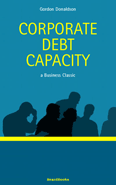An important book for corporate financial planners and managers to assist in determining debt financing and the establishment of borrowing limits.
This study focuses on how a company determines the wise and proper limitation
to borrowing, i.e., the appraisal of risk associated with debt financing and the
establishment of borrowing limits. It shows how successful industrial
corporations make the choice between debt and equity as the source of long-term
capital. The determination of debt capacity is the appropriate limit to the
amount of long-term debt outstanding at any point of time. The author explores
how the process of making this decision may be improved. This important and
interesting book is invaluable for corporate financial planners, corporate
managers, and for all students of finance and business.
| Chapter |
|
Page |
|
|
|
| PART ONE. A FIELD STUDY OF CORPORATE DEBT AND
RELATED FINANCIAL POLICIES |
| 1. |
Introduction |
3 |
| 2. |
Background: A Review of Twenty Years of Fund Flows |
27 |
| 3. |
Background: Basic Management Attitudes to External Sources
of Funds Other than Debt |
51 |
| 4. |
Management Attitudes Concerning the Use of Long-Term Debt |
68 |
| 5. |
Corporate Debt Policy and the Control of Risk |
93 |
|
|
|
| PART TWO. THE ANALYSIS OF CORPORATE DEBT
CAPACITY: AN APPRAISAL OF PRACTICE AND A PROPOSAL FOR IMPROVEMENT |
| 6. |
An Appraisal of Corporate Practice in the Use of Long-Term
Debt |
123 |
| 7. |
A Cash Flow Analysis for the Appraisal of Risk and the
Determination of Long-Term Debt Capacity |
156 |
| 8. |
The Application of a Recession Cash Flow Analysis to the
Debt-Equity Choice and Its Integration with Other Long-Term Policies |
193 |
| 9. |
A Review of the Debt Policies of Five Companies in the Light
of Their Simulated Recession Cash Flows |
223 |
|
|
|
|
APPENDICES |
|
| A. |
Company-by-Company Record of the Means by Which Funds Were
Provided in Years When Total Funds Applied Exceeded Internally Generated
Funds Plus Funds Released from Other Assets |
268 |
| B. |
A Probability Approach to the Evaluation of Corporate Debt
Capacity |
274 |
|
|
|
|
Selected Readings Related to the Subject of Corporate Debt
Capacity |
285 |
|
Index |
289 |
|
|
|
|
EXHIBITS |
|
| Number |
|
Page |
| 1 |
Classification of Company Experience in the Investment of
Funds in Terms of Long-Term Rate of Growth and Year-to-Year Variability |
35 |
| 2 |
Company Data on Internally Generated funds and Related
Information |
41 |
| 3 |
Company Data on Frequency of Use of External Sources of
Funds |
46 |
| 4 |
Typical Cash Budget Form |
73 |
| 5. |
Probability Table of Recession Sales Contractions |
172 |
| 6. |
Estimated Net Cash Flows Associated with the Anticipated
Adverse Limits of Recession Experience: Company "A" |
195 |
| 7. |
Results of Cash Flow Analysis as Shown in Exhibit 6,
Regrouped in Order of Increasing Net Cash Flows: Company
"A" |
197 |
| 8. |
Cash Solvency at the Limits of Adversity: Company
"A" -- Anticipated Recession Cash Balances Associated with the
Adverse Recession Cash Flow Assumptions of Exhibit 7 |
199 |
| 9. |
Cash Adequacy at the Limits of Adversity: Company
"A" -- Revision of Exhibit 8 Showing Maximum Adverse Recession
Cash Position after Provision for All Expenditures Considered by
Management to be Mandatory |
205 |
| 10. |
Cash Solvency at the Limits of Adversity: Company
"A" (Rubber Industry) -- Anticipated Recession Cash Position
Associated with Adverse Limits of Behavior of Determinants of Cash Flow:
Considering Only Those Expenditures Required to Generate Current Income |
226 |
| 11. |
Cash Adequacy at the Limits of Adversity: Company
"A" (Rubber Industry) -- Anticipated Recession Cash Position
Associated with Adverse Limits of Behavior or Determinants of Cash Flow:
Considering all Expenditures Given Priority over Debt Servicing |
227 |
| 12. |
Cash Solvency at the Limits of Adversity: Company
"B" (Baking Industry) |
236 |
| 13. |
Cash Adequacy at the Limits of Adversity: Company
"B" (Baking Industry) |
237 |
| 14. |
Cash Solvency at the Limits of Adversity: Company
"C" (Chemical Industry) |
244 |
| 15. |
Cash Adequacy at the Limits of Adversity: Company
"C" (Chemical Industry) |
245 |
| 16 |
Cash Solvency at the Limits of Adversity: Company
"D" (Drug Industry) |
250 |
| 17 |
Cash Adequacy at the Limits of Adversity: Company
"D" (Drug Industry) |
251 |
| 18 |
Cash Solvency at the Limits of Adversity: Company
"E" (Machine Tools Industry) |
256 |
| 19 |
Cash Adequacy at the Limits of Adversity: Company
"E" (Machine Tools Industry) |
258 |
| B-1 |
Table Showing All Possible Values for Collection from Sales
(Cs) Given Previous Assumptions Regarding S and ACP |
278 |
| B-2 |
Table Indicating Recession Net Cash Flows Associated with
All Possible Groupings of Determinants Arranged in Order of Decreasing
Adversity |
282 |

